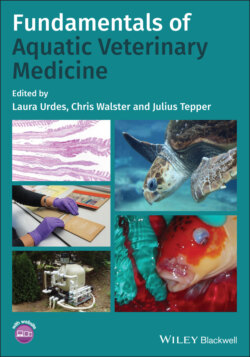Читать книгу Fundamentals of Aquatic Veterinary Medicine - Группа авторов - Страница 15
1.1 Introduction
ОглавлениеFor veterinarians to adequately evaluate the health or disease problems of aquatic animals, it is imperative that they understand the impact of, and assess the conditions in which the animal lives. Like terrestrial animals, the health of aquatic species is impacted by their environment. Suboptimal conditions can result in non‐infectious diseases or create situations favorable for opportunistic pathogens, which can lead to decreased growth, increased morbidity and clinical disease. It is therefore imperative to include an assessment of water quality and a history of any changes in the environment as part of a clinical evaluation of any health problem.
Fish health management is a term used in aquaculture to describe management practices designed to prevent fish disease. Once fish get sick it can be difficult to salvage them. Successful fish health management begins with prevention of disease rather than treatment, accomplished through, among other considerations, good water quality management. Without this foundation it is impossible to prevent outbreaks of opportunistic diseases. Fish are constantly bathed in potential pathogens, including bacteria, fungi, and parasites. Suboptimal water quality generally associated with stressful conditions allows potential pathogens to cause disease.
The biotic integrity of an ecological system is often reflected by the health of organisms that reside in that system. Proper management of the aquatic environment therefore offers optimum environmental conditions for the growth and better health of the cultivated fish. It also strengthens the defense mechanism of the body to fight against invading disease‐producing organisms. Eradicating any predatory or invasive fish species, disinfecting the pond, selecting quality and healthy seed for stocking, maintaining proper species ratios and stocking density, regulating water quality, as well as feeding and handling fish properly, are the various steps of these management measures.
With a very large number of cultured aquatic species, and hence different water systems in which they may live, the task of evaluating optimal conditions for every species may seem daunting. However, if considered on an ecosystem level for those that thrive naturally in freshwater, brackish or marine aquatic ecosystems, and evaluating these as life‐support systems for different taxa, the task is simplified. Furthermore, many biotic and abiotic physicochemical features of fresh, brackish or marine water bodies are similar, even for very different taxa.
This chapter provides general information about basic features of aquatic environments and life‐support systems important to the health of finfish, amphibians, mollusks, crustaceans and invertebrates that veterinarians might encounter. As aquatic mammals, birds and other homeothermic species are generally covered in veterinary curricula, they are not addressed here.
